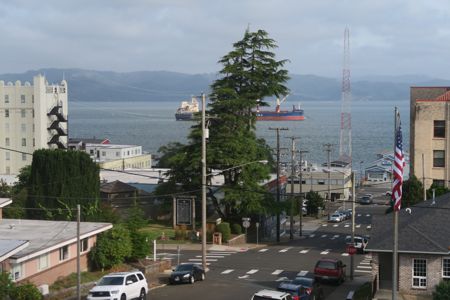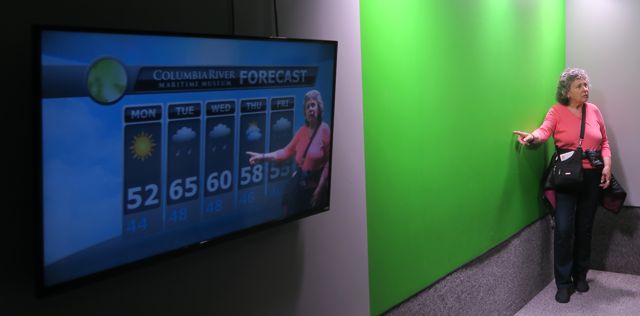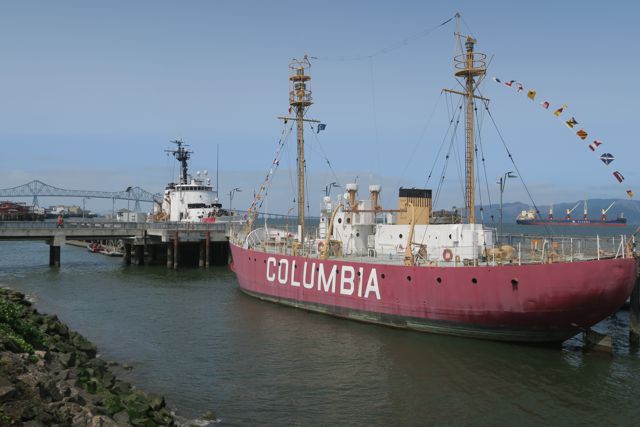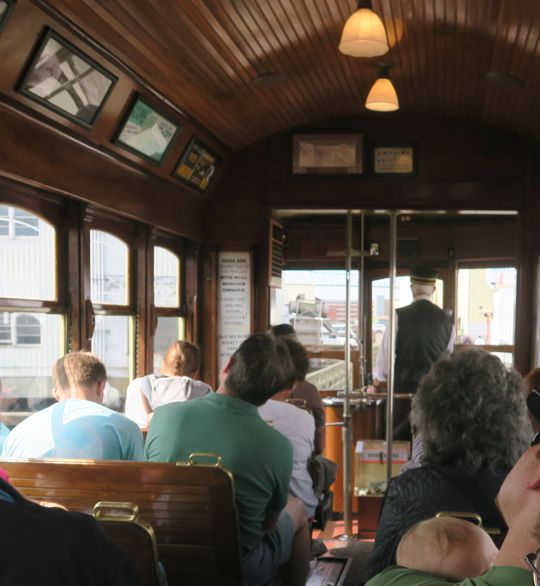| itinerary < 15 August Astoria 17 August > | Astoria 16 August 2018 |
Easy DayOut our northern porch window this morning, the Coaster that's been waiting rode at anchor. The fog looked to be lifting; small bits of blue scudded by overhead, and occasional bursts of sunlight spotlighted random roofs, trees, boats. Hostess Pam served a hearty breakfast; we could hear Dave hard at work in the kitchen behind the curtain. "Won't need lunch," opines Rochelle. Doubt that. We walked over to the Columbia River Marine Museum, an elegantly put-together collection of all the various forces that formed, and continue to form, this place where the mighty Columbia River encounters the much mightier Pacific Ocean. "The Bar" – the actual joining of the two, is famous as the Pacific Ship Graveyard: some 2,000 ships and uncounted lives have been lost here. The stories abound, from it's discovery in 1792, Lewis and Clark's 1805 winter, the Astor party's settlement in 1811, Salmon booms, fires, Coast Guard heroics... plenty of grist for a museum. |
 |
 |
In its fish-canning heyday, more than 50 canneries lined the steep shoreline, and fishermen from around the world flocked here to make their fortunes. "And then the fishery collapsed." I wonder why? Biologists tell us the difference between a symbiote and a parasite is that the former never kills its host. Lots of cool tech: a huge wall display of NOAA Sea Surface Currents and Tempertures, Chemistry, Clouds ...and folks standing and watching (and maybe understanding?)
|
|
Here Meteorologist Rochelle explains tomorrow's weather in front of the green screen. And here ...who is this?
That's a FLIR (infrared) image of me. |
 |
 Astoria-Megler Bridge and the Coast Guard Cutter Steadfast in the background |
Part of the museum offering, the Lightship Columbia used to be anchored just off the bar, to aid ships in finding the channel. It used lights, foghorns, and a strong directional radio beacon ...and was operated by a standard crew of 10, who lived aboard for weeks at a time through the roughest weather. Within (and sitting quietly at dockside) it seemed commodious enough, with bunk beds for sailors and little cabins for officers, but the explanatory texts described its motion in a storm as randomly bucking, not pitching and rolling like a regular ship. Both sound bad, but this sounds worse.
|
|
We hoofed it a mile downtown to find the Post Office, and then caught the volunteer-operated Astoria Trolley for an hour-ride along the waterfront. This is a very popular ride; due to our choice of stations, we got seats, but most of the way was standing room only. Passing under the long Astoria-Megler Bridge across the river to Washington state, I caught a picture of the old piling foundations of the canneries. |
 Astoria Trolley |
 |
|
Leaving the trolley at the museum, we walked across the street and joined the long, long line of folks waiting for their fish and chips at the Bowpicker, a boat-turned specialty food ...um, boat? rated #1 restaurant in Astoria. (I suspect, heavy points for uniqueness. The fish was tuna and very good, I must admit, but hardly worth a picture.)

If you must know, a Bowpicker is a type of fishing boat common on the Columbia before the salmon stock crashed (Thank you, Bonneville Power Authority) where the single fisherman picks salmon out of his gill nets from the bow (front) of his boat. Yes, thanks also to the fishermen for the collapse of the fishery. Now home to at least five breweries (and a distillery), they say, Astoria is a drinking city with a fishing problem.
Following the advice of our friends Sakina and Charles, we drove up the hill behind Astoria to the Astoria Tower, and climbed 164 steps to the top and a brilliant panoramic view of this corner of Oregon, thankfully visible since the marine layer has dissipated. The view from the top of the tower, even with today's haze (and the camera's inability to 'see' through the haze), is spectacular. (Reading the image below from right to left) Washington is North, the mouth of the Columbia and the bar is West, inland coastal Oregon is South, and Portland is invisible to the East. Astoria, proudly billing itself the "oldest American settlement west of the Mississippi" has used the spiral up the tower as a mural memorializing its history. Originally built and decorated in the 1920s for $23,000, it was restored in the 1990s for over $1 million. |
 |
|
 |
Dinner at the Fort George Brewery's upstairs pizza parlor. A great glass of cloudy IPA, plus an excellent pizza, a very garlicky Caesar, and a not-too-sweet piece of Carrot Cake. Twinky waitress, good view of the river outside and the Astorian populace inside.
|
 |
updated 18 November 2024 Caspar Time site software and photographs by the Caspar Institute except as noted this site generated with 100% recycled electrons! send website feedback to the CI webster © copyright 2002-2024 Caspar Institute |